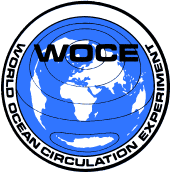Pathways of Deep and Bottom Water
in the Southwestern Brazil Basin:
(A local Synthesis of WOCE
Hydrographic and Direct Velocity Measurements)
Michal
Vanicek
Woods Hole Oceanographic Institution
Woods Hole, Massachusetts, USA
mvanicek@whoi.edu
Nelson
G. Hogg
Woods Hole Oceanographic Institution
Woods Hole, Massachusetts, USA
nhogg@whoi.edu
Abstract
The Vitoria-Trindade Seamount Chain near 20S in the Western Brazil Basin
is an important topographic barrier which interrupts the Deep Western
Boundary Currents of both the southward flowing deep water, and the northward
flowing bottom water. We present and compare the flow patterns of these
two water masses in this region as obtained three different ways:
-
from the neutrally buoyant float experiment at NADW and AABW levels,
-
from the hydrographic measurements,
-
and most importantly from a synthesis of hydrographic and direct velocity
measurements using a local, linear, box inverse model.
We focus on the DWBC and on the zonal flow offshore. The existence of the
DWBC is quite clear in the float data at the NADW level, but is less prominent
at the AABW level. In the interior the hydrographic data suggest a clear
separation in the direction of the deep water, zonal flow in agreement
with the floats which were mainly displaced zonally with unexpectedly mall
meridional space scales. Floats deployed more offshore at the NADW level
continue to the east after arriving at the Vitoria-Trindade Seamount Chain
while floats placed closer to he coast suggest a return to the western
boundary.



